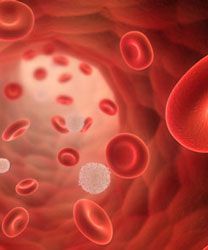Four-Drug Regimen Demonstrates Promising First-Line Findings for Older Patients With MCL
The treatment regimen of rituximab, bendamustine, bortezomib, and dexamethasone demonstrated activity and a manageable safety profile as a first-line therapy for patients with mantle cell lymphoma aged 65 years or older, according to findings from a prospective, multicenter phase II study.

The treatment regimen of rituximab (Rituxan), bendamustine, bortezomib (Velcade), and dexamethasone (RiBVD) demonstrated activity and a manageable safety profile as a first-line therapy for patients with mantle cell lymphoma (MCL) aged 65 years or older, according to findings from a prospective, multicenter phase II study.
The study investigators, led by Remy Gressin, MD, of the Center Hospital University of Grenoble, France, commented that “…our results identify the combination of rituximab, bendamustine, bortezomib, and dexamethasone, without maintenance therapy, as a promising treatment option in MCL patients ≥65 years old. The RiBVD regimen compares favorably with other treatment strategies used in this setting, although randomized trials are still lacking.”
The study was conducted across 37 centers of the Lymphoma Study Association and enrolled patients with MCL ≥65 years or <65 years if they were ineligible or unwilling to undergo autologous stem cell transplantation. Patients were enrolled between November 2011 and December 2012 and were monitored for 3 years after their last cycle of therapy.
The median patient age was 73 (range, 64-83) and the majority of patients were male (66%). Most patients (80%) had high-risk Mantle Cell Lymphoma International Prognostic Index (MIPI) scores and 59% had ≥30% Ki-67 positivity.
Of the 74 patients who received treatment on the study, 67 (90.5%) received at least 4 cycles of treatment and 59 (80%) received all 6 planned cycles. Following 4 cycles of therapy, the overall response rate (ORR) was 86.5% and the complete response (CR) rate (both confirmed and unconfirmed) was 56.5%. After 6 cycles, the ORR was 84% and the CR rate was 75.5%.
At a median follow-up of 52 months, the 2-year progression-free survival (PFS) and overall survival (OS) rates were 70.3% and 81.1%, respectively, among 74 evaluable patients, compared with 57.6% and 71.3% at 4 years. The investigators reported the study met its primary objective, which was to improve median PFS by 6 months compared with the reported 18-month PFS with R-CHOP (rituximab, cyclophosphamide, doxorubicin, vincristine, and prednisone).
“The 4-year PFS (57.6%) observed here for RiBVD-treated patients is in line with the median PFS reported for the BR regimen (bendamustine and rituximab; 35.4 months) and other bortezomib-containing regimens, such as 24.7 months for VR-CAP (bortezomib, rituximab, cyclophosphamide, doxorubicin, and prednisone) and 26 months for the RiPAD+C regimen (rituximab, bortezomib, doxorubicin, dexamethasone, and chlorambucil),” the investigators wrote.
Forty-nine of 74 patients (66.2%) developed grade 3/4 hematologic toxicities, including neutropenia in 51%, thrombocytopenia in 35%, and anemia in 19%. Neutropenia translated into febrile neutropenia in 11 patients (11%), which was grade 3/4 in 6 patients. Sixty-five percent of patients experienced lymphopenia at the end of treatment, which was mainly grade 3/4. Persistent grade 3/4 lymphopenia was seen in 28.8% of the 59 surviving patients at 1 year following the end of treatment.
Non-hematologic grade 3/4 toxicities were seen in 42 patients (56.7%) at the end of treatment, the most frequent being fatigue, peripheral neuropathy, and fever with or without neutropenia.
Grade 2 to 4 neuropathy was seen in 21.5% of patients and was generally reported after cycle 3 of treatment. Bortezomib was stopped indefinitely in 10 of the 11 patients with grade 3/4 neurotoxicity but not in cases of grade 2 toxicity.
Partial reversibility of neuropathy was reported in 13 of the 16 patients (81%) with grade 2 to 4 neurotoxicity.
Overall, 24 patients died, 4 during treatment (2 from cardiac arrest, 1 with pneumonia, and 1 with progressive multifocal leukoencephalopathy, after cycle 3) and 20 during follow-up (16 due to progressive disease, 1 from pancreatic adenocarcinoma, 1 from cardiac arrest, and 2 from unknown causes).
Investigators also assessed molecular minimal residual disease (MRD) at baseline, after 4 courses of treatment, and at the end of treatment. MRD was assessed in peripheral blood and bone marrow until progression or relapse, for a maximum follow-up of 3 years.
After 4 courses of treatment, 50 of 57 patients analyzed were negative for molecular MRD (32 in CR and 18 in partial response [PR]) and 7 patients were positive for MRD (2 in CR, 1 in PR, and 1 with stable disease). At the completion of treatment, 41 of 54 patients analyzed were MRD-negative (39 in CR, 1 in PR, and 1 with stable disease) and 13 were MRD-positive (8 in CR, 4 in PR, and 1 with progressive disease).
MRD status in the peripheral blood at the conclusion of treatment was the most highly predictive factor for both PFS and OS (P<.0001). The 4-year OS rate for patients who had MRD negativity in the blood after treatment was 86.6% compared with 28.6% in patients who were MRD positive. Continued MRD negativity was also significantly associated with longer PFS, with a 4-year PFS rate of 97%.
Reference:
Gressin R, Daguindau N, Tempescul A, et al. A Phase 2 Study of Rituximab, Bendamustine, Bortezomib And Dexamethasone For First-Line Treatment Of Older Patients With Mantle Cell Lymphoma.Haematologica. 2018; 104(1):138-146. doi: 10.3324/haematol.2018.191429.
Liso-Cel Delivers Deep, Durable Responses in R/R MCL
January 11th 2024High complete response rates and low incidences of cytokine release syndrome and neurological events were observed when patients with relapsed or refractory mantle cell lymphoma were treated with lisocabtagene maraleucel.
Read More
ZUMA-18 Study Shows Brexu-cel's Therapeutic Potential in MCL
January 3rd 2024In an interview with Targeted Oncology, Andre Goy, MD, discussed the potential of brexucabtagene autoleucel for the treatment of patients with relapsed/refractory mantle cell lymphoma and how 2 studies provide support for use of the agent in this patient population.
Read More